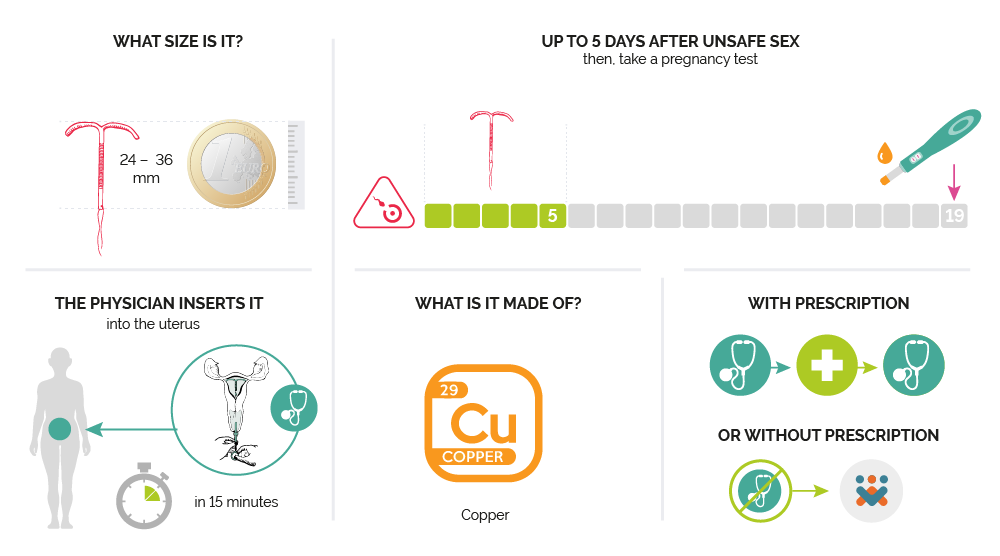
The Emergency Copper-IUD
The emergency copper IUD is also known as copper intrauterine device (IUD)
* Efficacité pratique : efficacité mesurée dans des conditions d’utilisation courante (prise en compte des oublis, échecs…)
** Efficacité théorique : efficacité observée dans des conditions d’utilisation parfaite (sans problème d’utilisation et sans interaction avec d’autres médicaments)
Source : les pourcentages d’efficacité sont tirés de l’OMS (2018)
HOW DOES IT WORK?
The copper-IUD (for IntraUterine Device) is also a method of emergency contraception. Copper makes sperm inactive and acts on the inner lining of the uterus (endometrium), preventing the implantation of a possible fertilized egg. While it is among the safest contraceptives, it is also the most effective emergency contraception. The copper IUD can be used as emergency contraception up to 5 days after unsafe sexual intercourse.
Contrary to popular belief, the copper IUD does not reduce fertility, does not require surgery, and is suitable for a person who never had any children.
INTERESTING FIGURES AND DETAILS

HOW TO USE IT?

Context
You had a sexual intercourse without protection or in case of contraception’s failure (forgotten, doubt, bad use, or contraception’s incident). When should you take an emergency contraception?
Step 1
Take an emergency appointment at the Planning Familial or at your physician, gynaecologist to have the copper IUD inserted as soon as possible.
Step 2
It may be advised to take pain relief medicine when the copper IUD is inserted.
Step 3
At the end of the IUD are two thin strings which, after insertion by the gynaecologist or physician, are left outside the cervix and are cut to correct length to avoid any discomfort during sexual intercourse.
Step 4
The copper IUD is effective right after the insertion.
And afterwards
If an STI screening has not been done for a long time, it is recommended to ask for it at your physician, gynaecologist or at the Planning Familial.
WHERE TO GET IT?
Starting 1 April 2023, this contraceptive is delivered free of charge on medical prescription in any Luxembourg pharmacy to people affiliated with the National Health Fund, with no age limit.
For more information: click here.
This contraceptive can also be delivered for free at the Family Planning, including to people not covered by National Health Fund.
The copper-IUD cost on average between 100-120€* and last 5 to 10 years.
*(The price is an average indication which may vary)

Frequently asked questions
Is it true that the copper IUD can replace the emergency pill?
Yes, the copper IUD can be used as emergency contraception in the same way as the emergency pill. It should be inserted within 5 days following unprotected intercourse. It is acutally more effective than the emergency pill in preventing pregnancy. Indeed, it prevents fertilisation of the ovum thanks to the spermicidal action of copper, which makes the sperm inactive. In addition, the presence of the copper IUD will reduce the chances of implantation. You can see with your gynaecologist to have it inserted as a matter of urgency.
Do I risk losing my copper IUD in the toilet?
No. But if you want to make sure it is there, insert two fingers into the vagina and look for the two threads. Do not pull on them. If you do not feel anything, consult your physician.
Is it possible to have an IUD inserted directly after giving birth?
It is not a bad idea, but the insertion of a copper IUD should not take place until 4-8 weeks after the birth. It may take up to 12 weeks after delivery for the uterus to return to its original position.
Is the copper IUD less effective than the hormonal IUS?
No. Both are similarly effective: over 99% effective. The copper IUD is 99.2% to 99.4% effective but can be kept for 5 to 10 years depending on the model. The hormonal IUS is 99.8% effective and can be kept for up to 5 years.
Does the IUD cause infertility?
The IUD does not case sterility nor infertility. In fact, this contraception is reversible, i.e. fertility returns in the months following its removal.
Can the insertion or removal of a copper IUD cause pain?
The insertion of the copper IUD into the uterus can be a little painful, similar to the pain associated with menstruation. If you strongly anticipate pain, you can discuss this with your physician. There are several ways to minimise the pain, such as taking painkillers before and after insertion, or inserting the IUD during menstruation (the cervix is more open then), etc. However, it should be noted that the vast majority of women experience only mild, bearable pain, and that this pain subsides within 24 hours. It is possible to have an IUD inserted during or outside the menstrual period.
Removal is usually painless. As the IUD is T-shaped, it folds back on itself, making it easier to remove.
Do I have period while having the IUD ?
With the copper IUD, you will continue to have periods as in a “natural” cycle. This is because the copper IUD does not contain any hormones. Some women report heavier or longer periods. In the meantime, spotting, i.e. blood loss outside of the period, may be present. If you are uncomfortable with bleeding or have questions about this contraception, do not hesitate to talk to a physician, gynaecologist or pharmacist.
If my IUD is removed, am I still protected for a few days?
No. The IUD, whether hormonal or copper, does not protect once it is removed. In fact, it is important not to have sex in the 5 days before the hormonal or copper IUD is removed. If you do, then you should keep the IUD and make an appointment for a later date. If you have had sex in the last 5 days using another method of contraception (e.g. condom), then you can have the IUD removed.
The reason? The copper IUD as well as the hormonal IUD does not prevent ovulation from occurring. At the same time, it is important to know that sperm can live for up to 5 days in the woman’s body. Thus, if ovulation, sexual intercourse and withdrawal take place within the same 5 days, this could lead to an unwanted pregnancy.
How long can you keep an IUD (intrauterine device)?
The copper IUD can be kept for 5 years. In some cases, it can be kept longer, subject to the advice of a health professional.
Please note: If you want to have your copper IUD replaced, the removal of the current IUD and the insertion of the new one must be done on the same day, otherwise the risk of pregnancy is high. If you remove your copper IUD and do not wish to become pregnant, you must immediately
take another method of contraception.
Should I check if my IUD is still there?
If you have doubts, you can always insert your fingers into your vagina and check if you can feel the 2 small threads coming out of your cervix. If you do not feel them, which does not necessarily mean that your IUD is no longer in place, you can make an appointment with your gynaecologist or physician or at the Family Planning.
Someone having a hormonal IUS or a copper IUD should normally see his/her gynaecologist at least once a year to check that everything is in order with regard to the location of the IUD. If you have any doubts, do not hesitate to make an appointment with your physician/gyneacologist.
Is it possible to have an IUD inserted even if I have no children?
Yes, if you have no contraindications (e.g. a history of ectopic pregnancy – to be discussed with your physician), you can have an IUD inserted, even if you are under 18. These possible contraindications are identified by your physician. Do not hesitate to ask your health care professional questions if needed.


